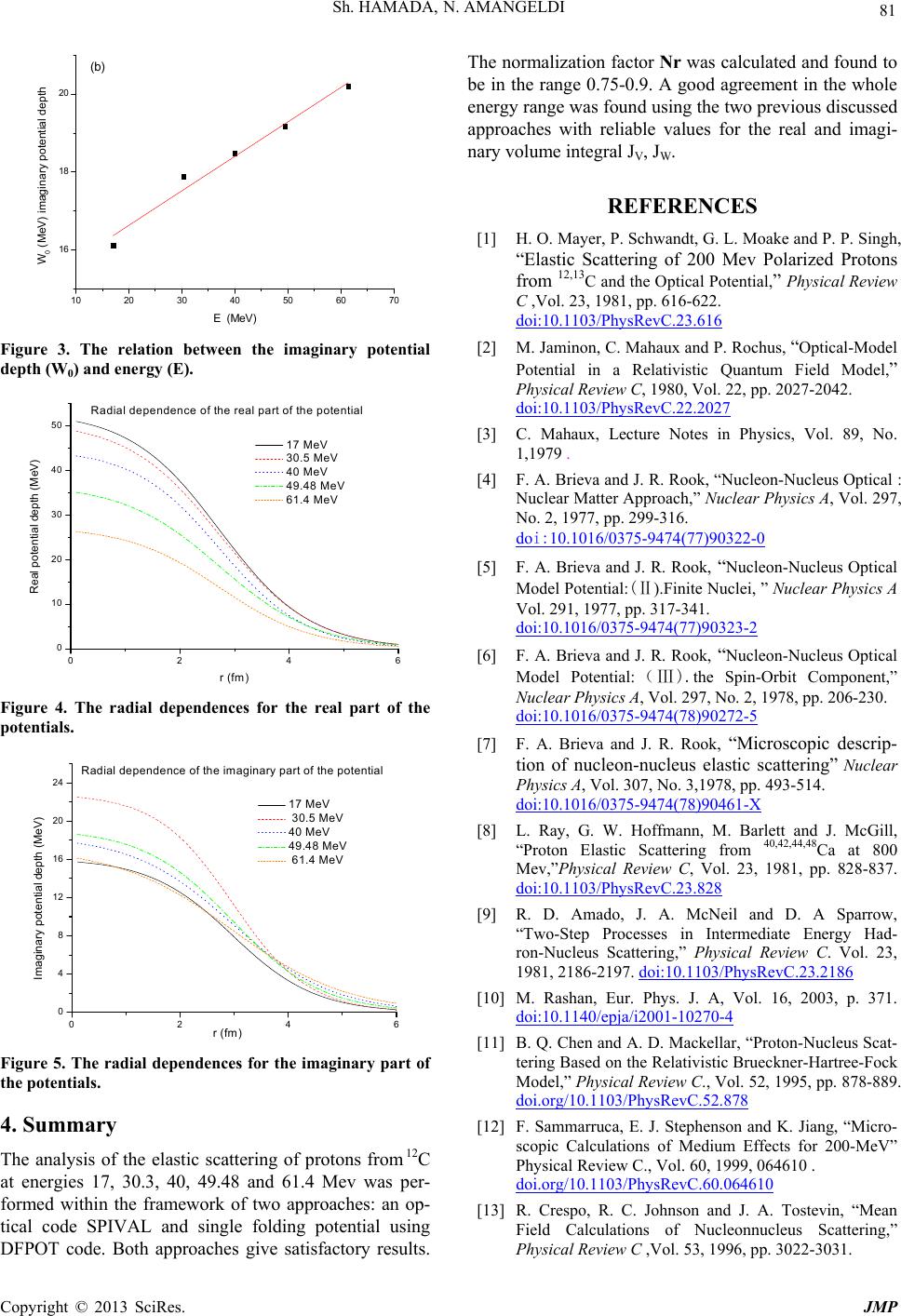
Sh. HAMADA, N. AMANGELDI 81
10 20 30 40 50 60 70
16
18
20
W0 (MeV) imaginary potential depth
(b)
E (MeV)
Figure 3. The relation between the imaginary potential
depth (W0) and energy (E).
024
0
10
20
30
40
50
6
Real potential depth (MeV)
r (fm)
17 MeV
30.5 MeV
40 MeV
49.48 MeV
61.4 MeV
Radial dependence of the real part of the potential
Figure 4. The radial dependences for the real part of the
potentials.
0246
0
4
8
12
16
20
24
r (fm)
Radial dependence of the imaginary part of the potential
17 MeV
30.5 Me V
40 MeV
49.48 MeV
61.4 Me V
Imaginary potential depth (MeV)
Figure 5. The radial dependences for the imaginary part of
the potentials.
4. Summary
The analysis of the elastic scattering of protons from 12C
at energies 17, 30.3, 40, 49.48 and 61.4 Mev was per-
formed within the framework of two approaches: an op-
tical code SPIVAL and single folding potential using
DFPOT code. Both approaches give satisfactory results.
The normalization factor Nr was calculated and found to
be in the range 0.75-0.9. A good agreement in the whole
energy range was found using the two previous discussed
approaches with reliable values for the real and imagi-
nary volume integral JV, JW.
REFERENCES
[1] H. O. Mayer, P. Schwandt, G. L. Moake and P. P. Singh,
“Elastic Scattering of 200 Mev Polarized Protons
from 12,13C and the Optical Potential,” Physical Review
C ,Vol. 23, 1981, pp. 616-622.
doi:10.1103/PhysRevC.23.616
[2] M. Jaminon, C. Mahaux and P. Rochus, “Optical-Model
Potential in a Relativistic Quantum Field Model,”
Physical Review C, 1980, Vol. 22, pp. 2027-2042.
doi:10.1103/PhysRevC.22.2027
[3] C. Mahaux, Lecture Notes in Physics, Vol. 89, No.
1,1979 .
[4] F. A. Brieva and J. R. Rook, “Nucleon-Nucleus Optical :
Nuclear Matter Approach,” Nuclear Physics A, Vol. 297,
No. 2, 1977, pp. 299-316.
doi:10.1016/0375-9474(77)90322-0
[5] F. A. Brieva and J. R. Rook, “Nucleon-Nucleus Optical
Model Potential:(Ⅱ).Finite Nuclei, ” Nuclear Physics A
Vol. 291, 1977, pp. 317-341.
doi:10.1016/0375-9474(77)90323-2
[6] F. A. Brieva and J. R. Rook, “Nucleon-Nucleus Optical
Model Potential:(Ⅲ).the Spin-Orbit Component,”
Nuclear Physics A, Vol. 297, No. 2, 1978, pp. 206-230.
doi:10.1016/0375-9474(78)90272-5
[7] F. A. Brieva and J. R. Rook, “Microscopic descrip-
tion of nucleon-nucleus elastic scattering” Nuclear
Physics A, Vol. 307, No. 3,1978, pp. 493-514.
doi:10.1016/0375-9474(78)90461-X
[8] L. Ray, G. W. Hoffmann, M. Barlett and J. McGill,
“Proton Elastic Scattering from 40,42,44,48Ca at 800
Mev,”Physical Review C, Vol. 23, 1981, pp. 828-837.
doi:10.1103/PhysRevC.23.828
[9] R. D. Amado, J. A. McNeil and D. A Sparrow,
“Two-Step Processes in Intermediate Energy Had-
ron-Nucleus Scattering,” Physical Review C. Vol. 23,
1981, 2186-2197. doi:10.1103/PhysRevC.23.2186
[10] M. Rashan, Eur. Phys. J. A, Vol. 16, 2003, p. 371.
doi:10.1140/epja/i2001-10270-4
[11] B. Q. Chen and A. D. Mackellar, “Proton-Nucleus Scat-
tering Based on the Relativistic Brueckner-Hartree-Fock
Model,” Physical Review C., Vol. 52, 1995, pp. 878-889.
doi.org/10.1103/PhysRevC.52.878
[12] F. Sammarruca, E. J. Stephenson and K. Jiang, “Micro-
scopic Calculations of Medium Effects for 200-MeV”
Physical Review C., Vol. 60, 1999, 064610 .
doi.org/10.1103/PhysRevC.60.064610
[13] R. Crespo, R. C. Johnson and J. A. Tostevin, “Mean
Field Calculations of Nucleonnucleus Scattering,”
Physical Review C ,Vol. 53, 1996, pp. 3022-3031.
Copyright © 2013 SciRes. JMP